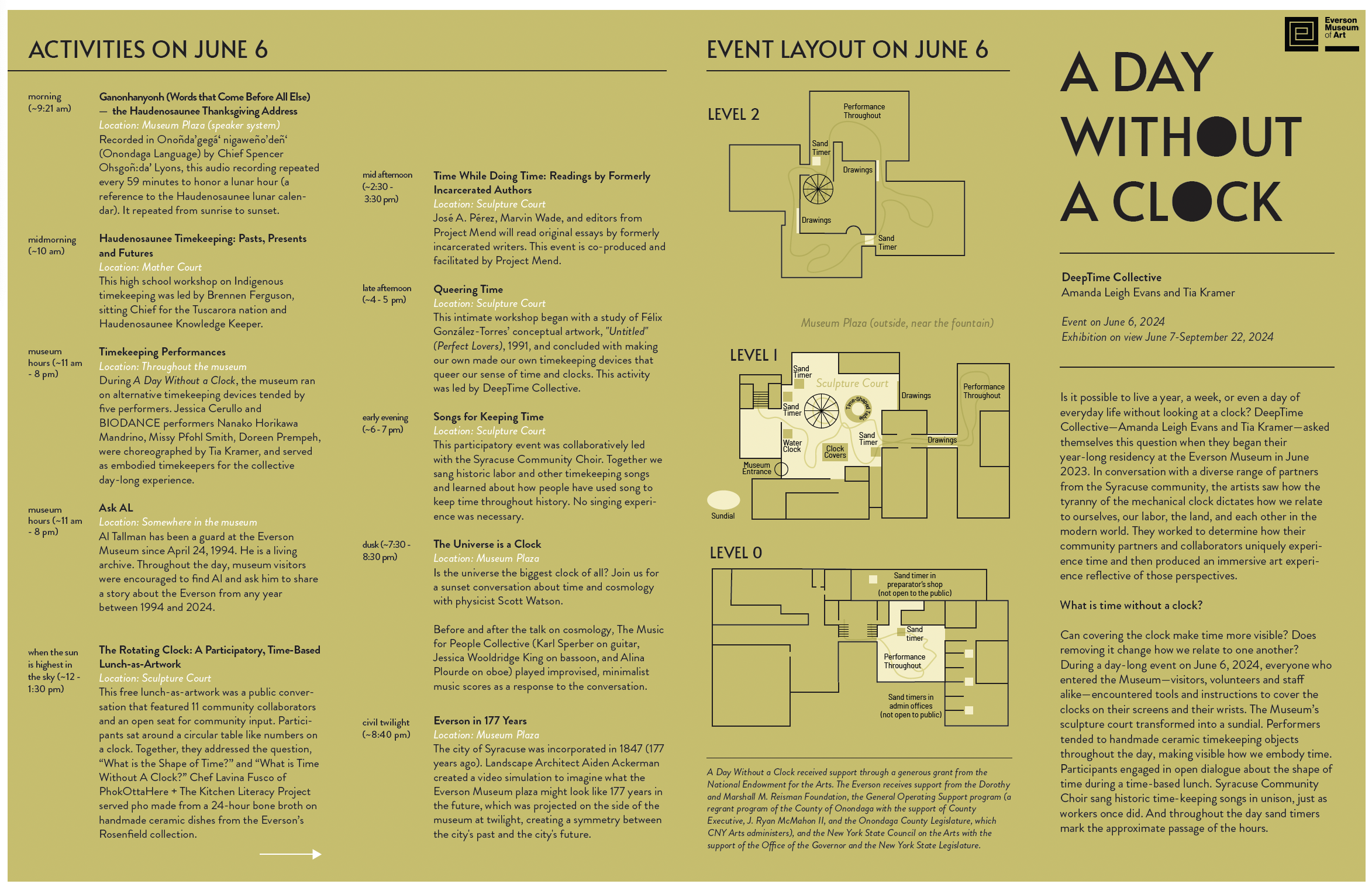A Day Without A Clock
2024
DeepTime Collective (Amanda Evans + Tia Kramer)
Immersive day-long event followed by a solo exhibition
Everson Museum of Art, Syracuse, NY
Produced during year-long artist residency by invitation (support from Garth Johnson and Adam Carlin)
View full event schedule HERE.
What is Time Without a Clock?
The clock is a tool for standardizing and measuring time. A Day Without A Clock was not a day without any clocks, but rather a day without the mechanical clock that we collectively agree upon and allow to guide our daily lives.
DeepTime Collective’s day-long immersive artwork experience, A Day Without A Clock, eliminated the mechanical clock as a familiar tool. Throughout the day, the artists hosted a series of sequential, time-based public events developed in collaboration with community partners. To facilitate these events, the artists created alternative timekeeping devices for museum staff, visitors, and collaborators to remain grounded despite the absence of the clock. Around the museum, visitors and staff discovered tools crafted by the artists to maintain the museum’s regular functions despite the disruption caused by the absence of a clock. Additionally, the artists staged an intensive 10-hour performance to ensure the alternative clocks kept running with some semblance of accuracy.
During this process, DeepTime Collective revealed that to create an institutional experience without a clock, the artists themselves had to embody the role of the clock. Precision was crucial, yet impossible to maintain through the softness the body. While some of the artists’ tools were accurate, others were not. These tools were crafted and maintained by hand, which inherently has its limitations. Consequently, no one, including the artists, knew the exact time at any point during A Day Without A Clock.
Participants needing to know the time during A Day Without A Clock were encouraged to consult multiple timekeeping devices to approximate the hour and minute of the day. The more devices they encountered, the more accurately they could determine the time. These devices shed light on how the mechanical clock dictates our personal and collective experiences.
Alternative Timekeeping Devices
Sculpture Court Sundial
Architect I.M. Pei designed the Everson Museum on a strict
North-South axis, which makes the sculpture court act like a
sundial. Shadows move rapidly across the floor and walls,
illustrating the passage of the hours. The position of the sun
shifts day by day and season by season.
In preparation for A Day Without A Clock, the artists used
long black tape lines and drawings on windows to mark the sun’s movement. These lines
were the best approximation of time inside the museum. In
addition to taped lines, the artists made drawings on windows
to mark how light moves inside and outside the building.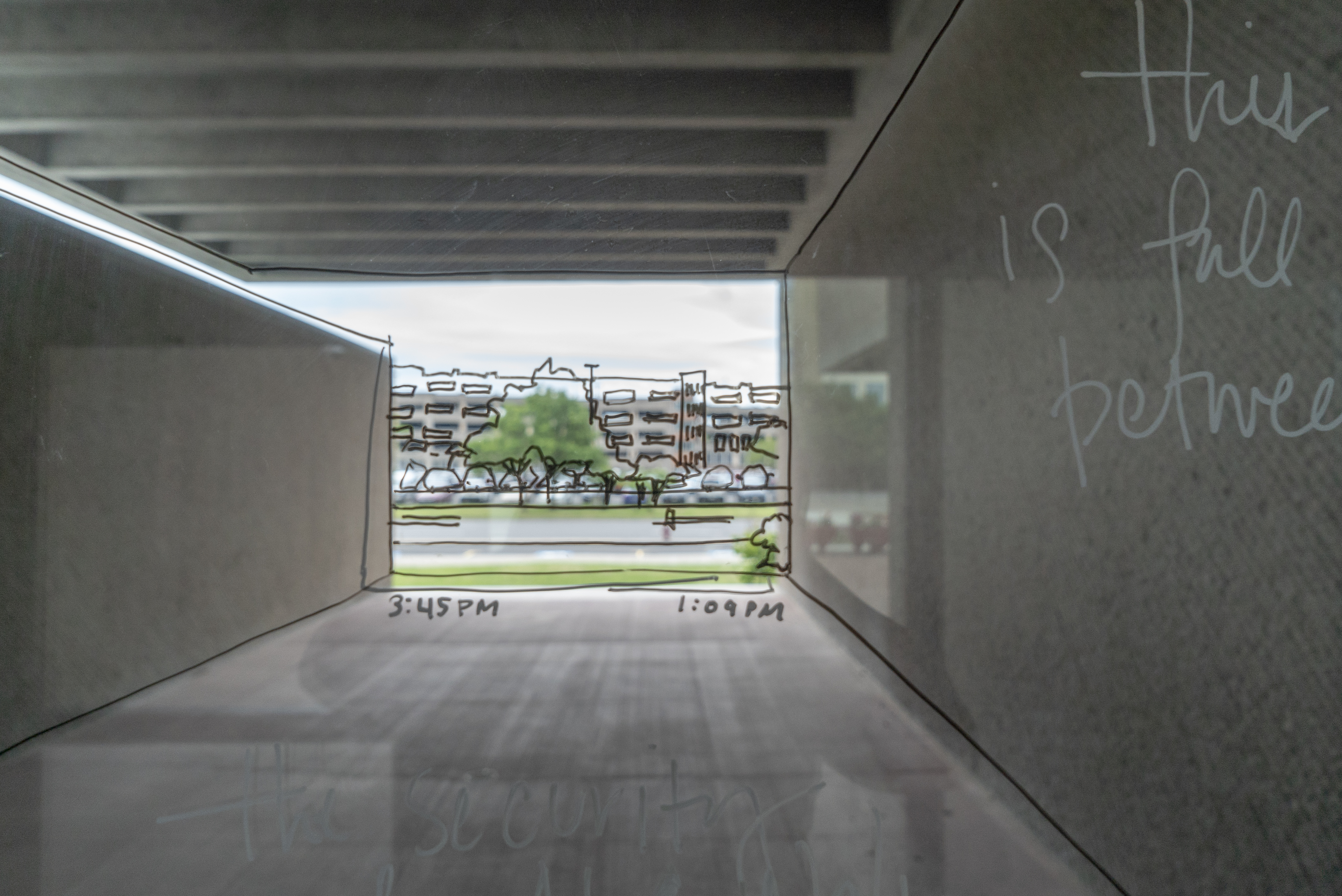
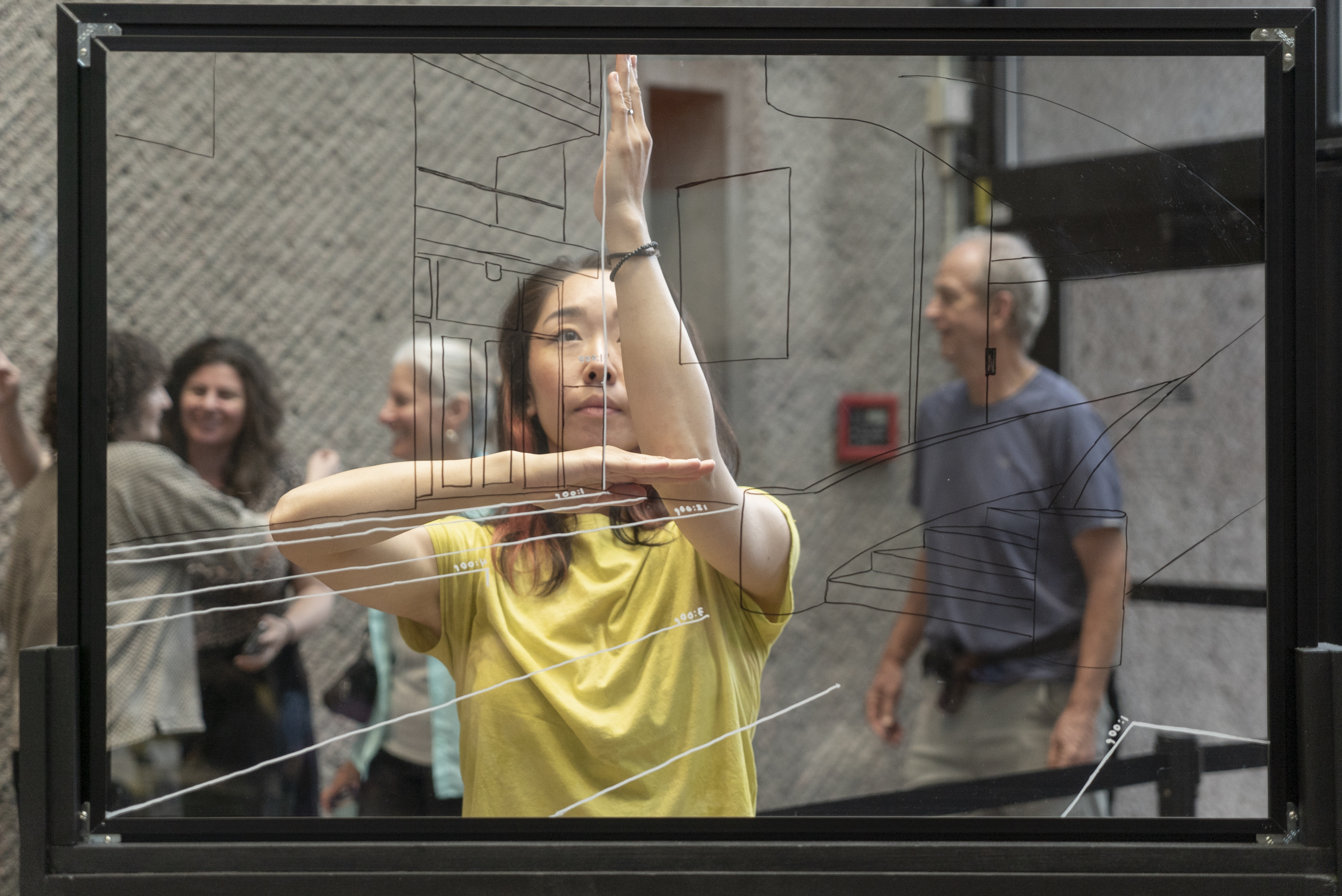
Clock Covers
Covering one’s clocks, rather than removing the clock
completely, draws attention to our use of the tool. During
the day-long event on June 6, 2024, everyone who entered
the museum—visitors, volunteers and staff alike—were
offered tools and instructions to cover the clocks on their
screens and their wrists.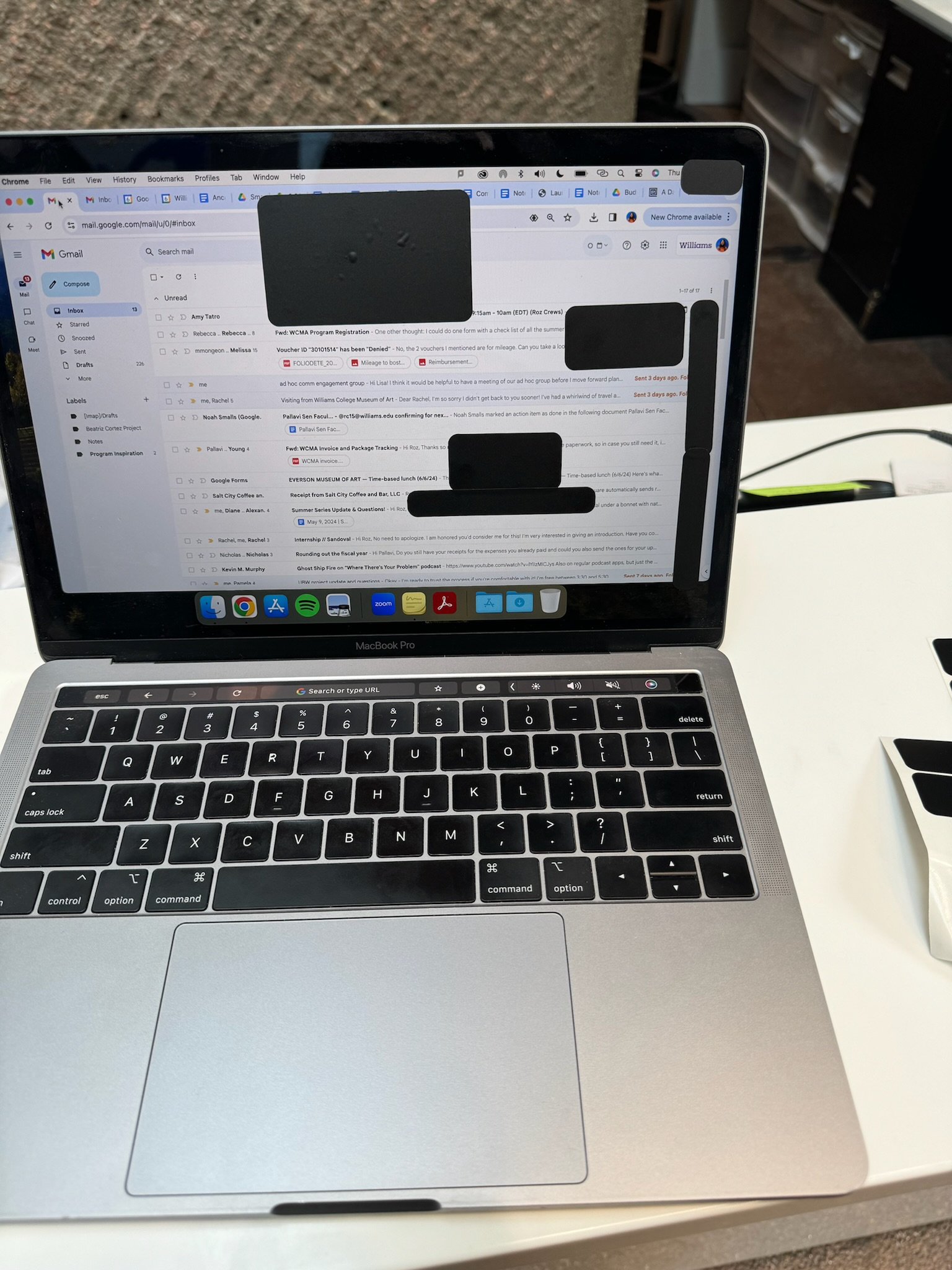
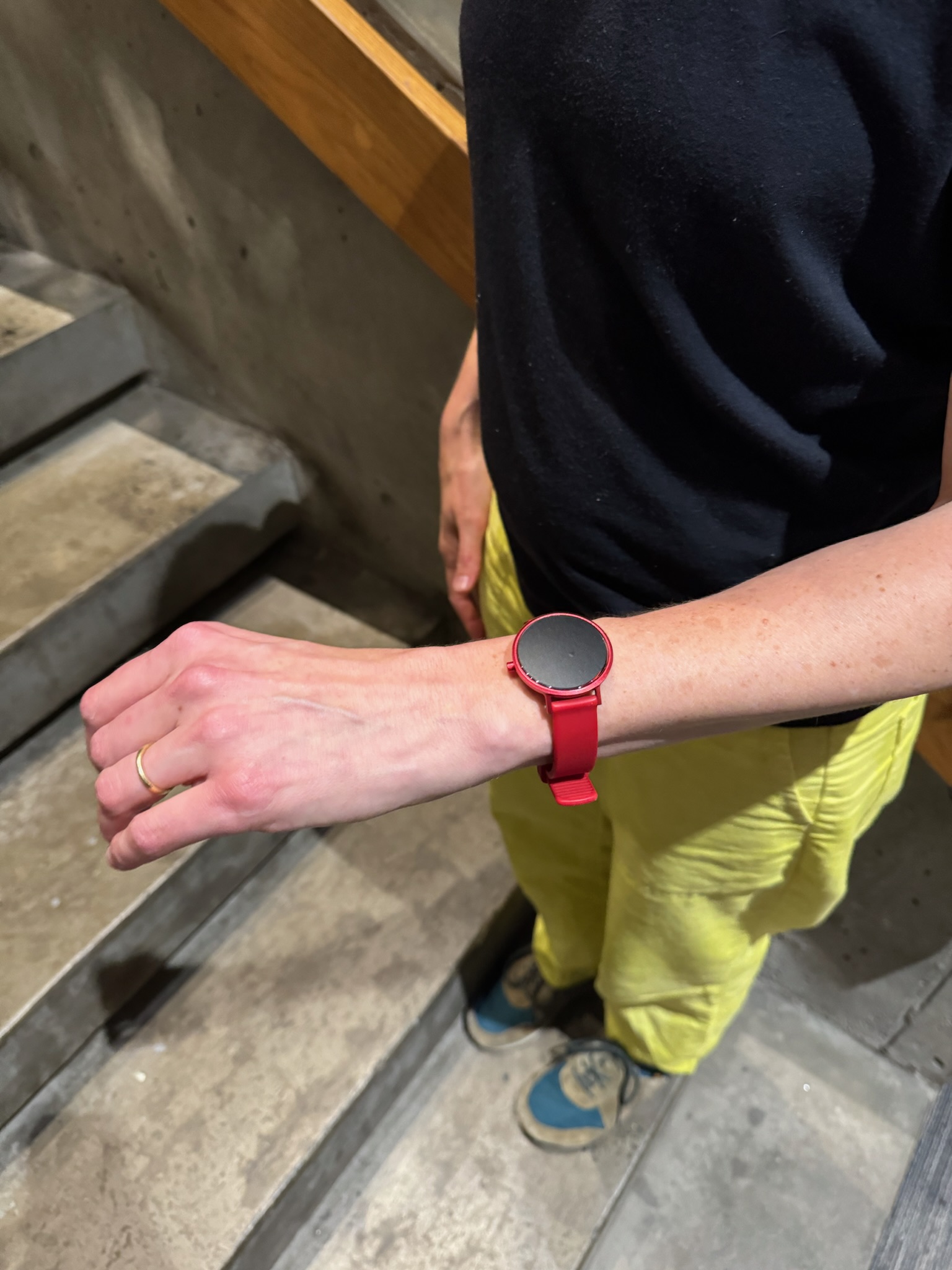
Human Sundial
The artists placed a large sundial–calibrated to the Everson’s
longitude and latitude–in the museum’s plaza. When visitors
stood on the sundial, the human body acted as a gnomon and
the head's shadow marked the approximate hour and minute.
Our experience of time is centered in our bodies.

Sand Timers and a Water Clock
During A Day Without a Clock, sand timers and a water clock measured the approximate passage of the hours. DeepTime Collective created the ceramic objects in this exhibition as alternative, functional timekeeping devices responding to their research on history of clockmaking, capitalism, and colonial globalization. These objects were placed on each major area of the museum, including staff office spaces, and were tended to hour-by-hour by performers and museum guards.



Sand Timer Livestream
Most of the Everson Museum staff work in the basement of the building. Staff work in office cubicles without access to sunlight or visual awareness of life upstairs. Staff working without a clock on A Day Without A Clock were unmoored from the natural tools that mark the passage of minutes and hours. DeepTime Collective livestreamed their most accurate sand timer for staff to access throughout the day, grounding and connecting them to the collective experience.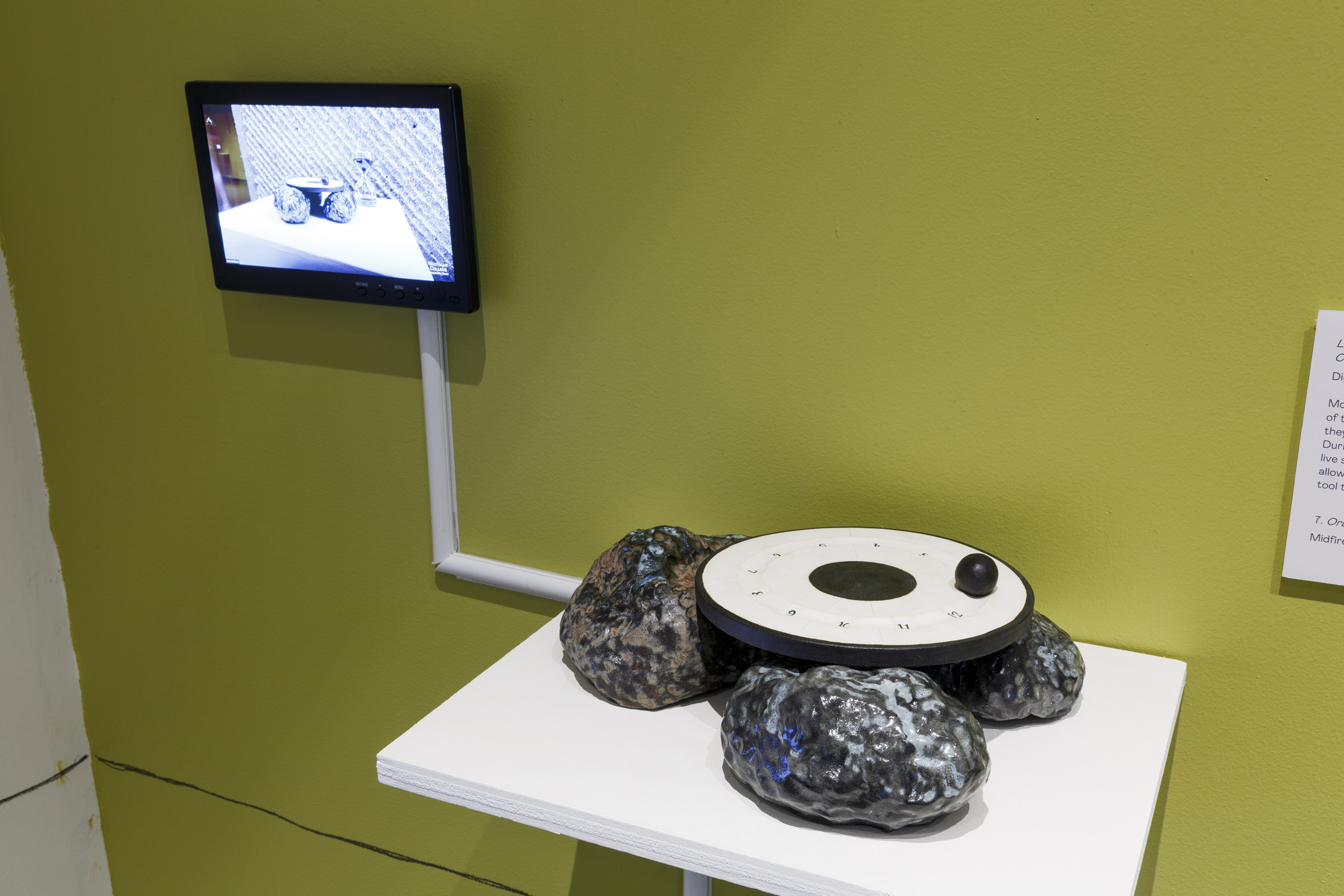
Time-Shaped Table
DeepTime Collective designed a modular circular table that breaks into four equal parts. This object was the center of all collective events during the immersive event, A Day Without A Clock, and changed shape from one event to the next. The table’s many forms mirror the shapes community collaborators described as their visions of the “Shape of Time.”
Museum Guards
The museum guards keep time as they rotate throughout
the museum. The artists incorporated their observations,
gestures of waiting, and insights on time into the objects,
gestures, drawings, texts and events featured in A Day
Without A Clock.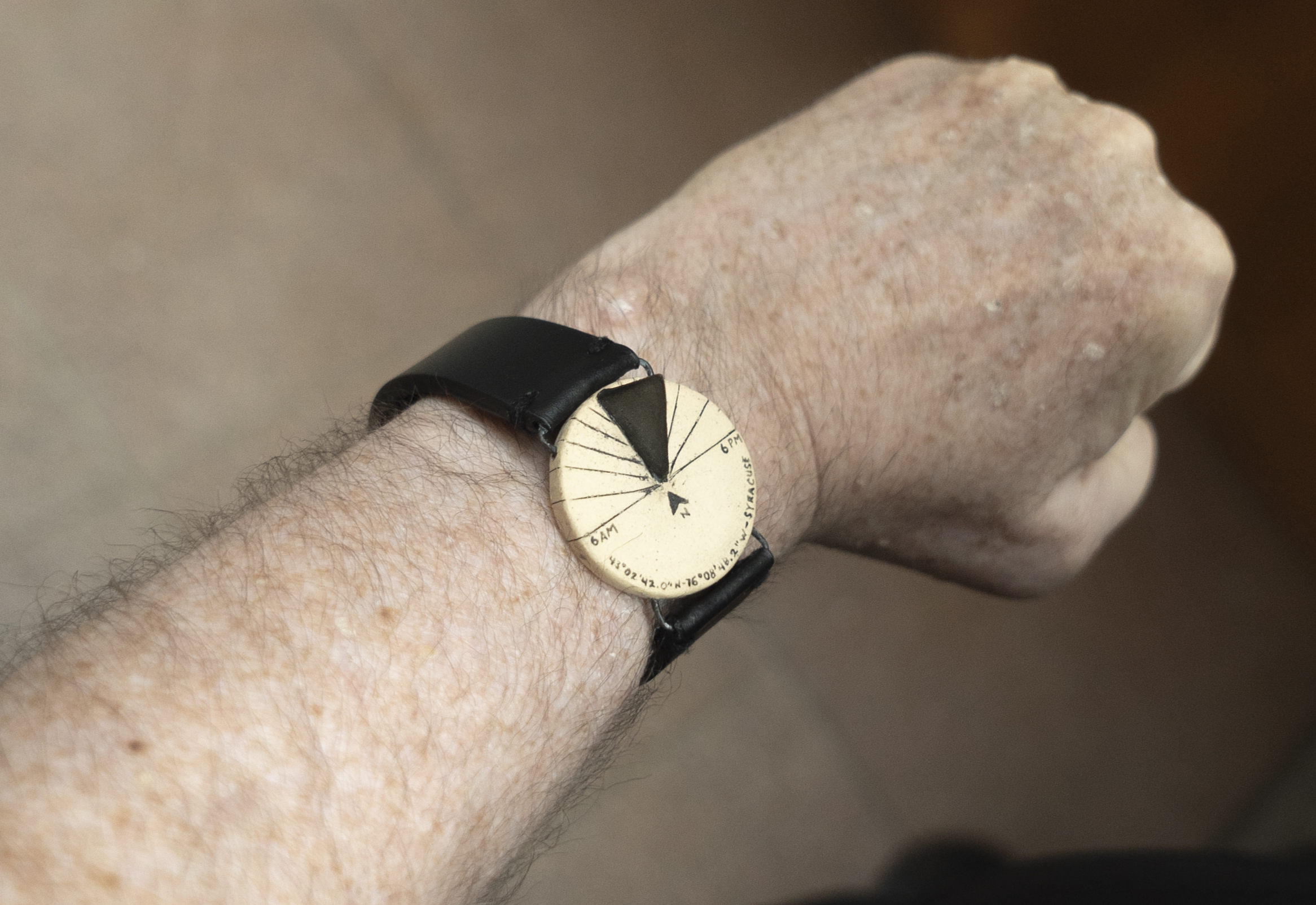
Time Tenders (Performers)
Throughout A Day Without A Clock, five performers served
as time tenders. Their primary function was to tend to the
alternative timekeeping positioned throughout the building.
The performers flipped sand timers at the top of every
approximate hour and checked the timers against the sun.
Their work allowed the collective series of events to settle
into the unknown.
Time and space, according to physics, and our lived experiences, are inextricably connected. To tend to time is to tend
to space. To tend to space is to tend to time.
The performers were instructed to be fully in their body.
Guided by their own human needs, they created gestural
scores that enact when a need or desire arrives. For
example, when curious about clock time, they might look
over their left shoulder. Or when tired, they might run in
patterns that depict the shapes of time according to the
drawings of the shapes of time included on the exhibition
walls. As visitors witnessed performers in their heightened
state of awareness, they were invited to enter into time and
the act of tending time with the performers.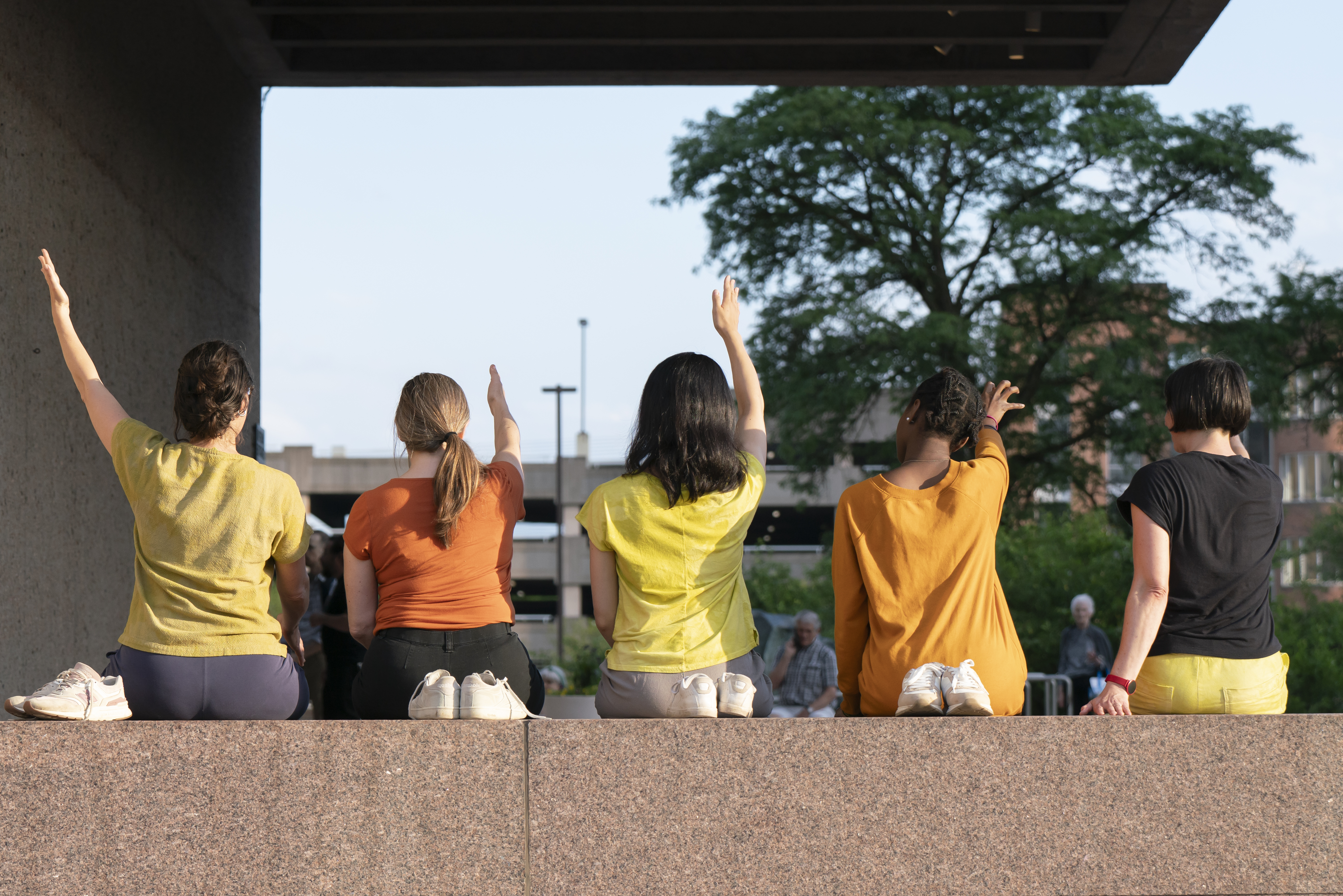
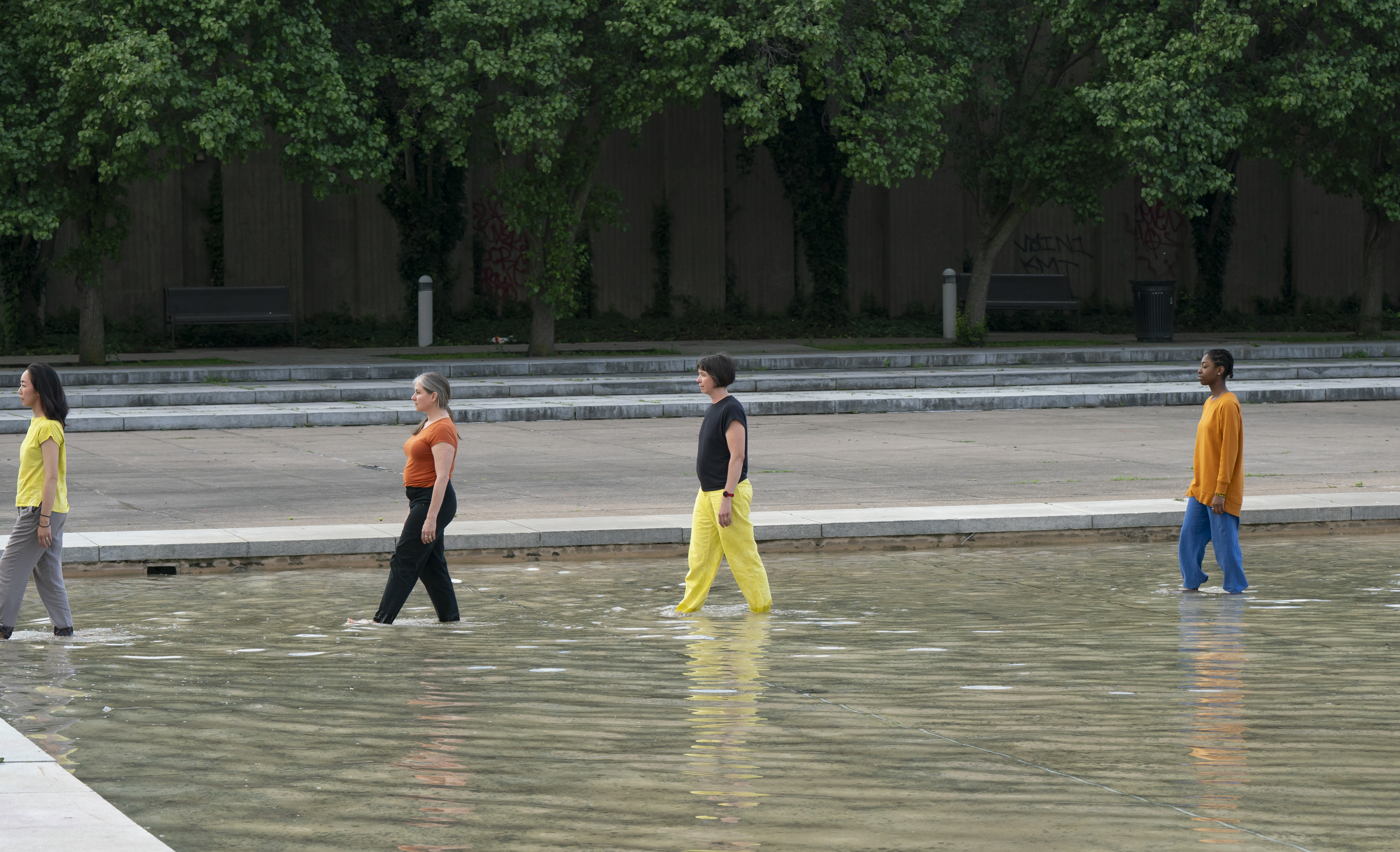

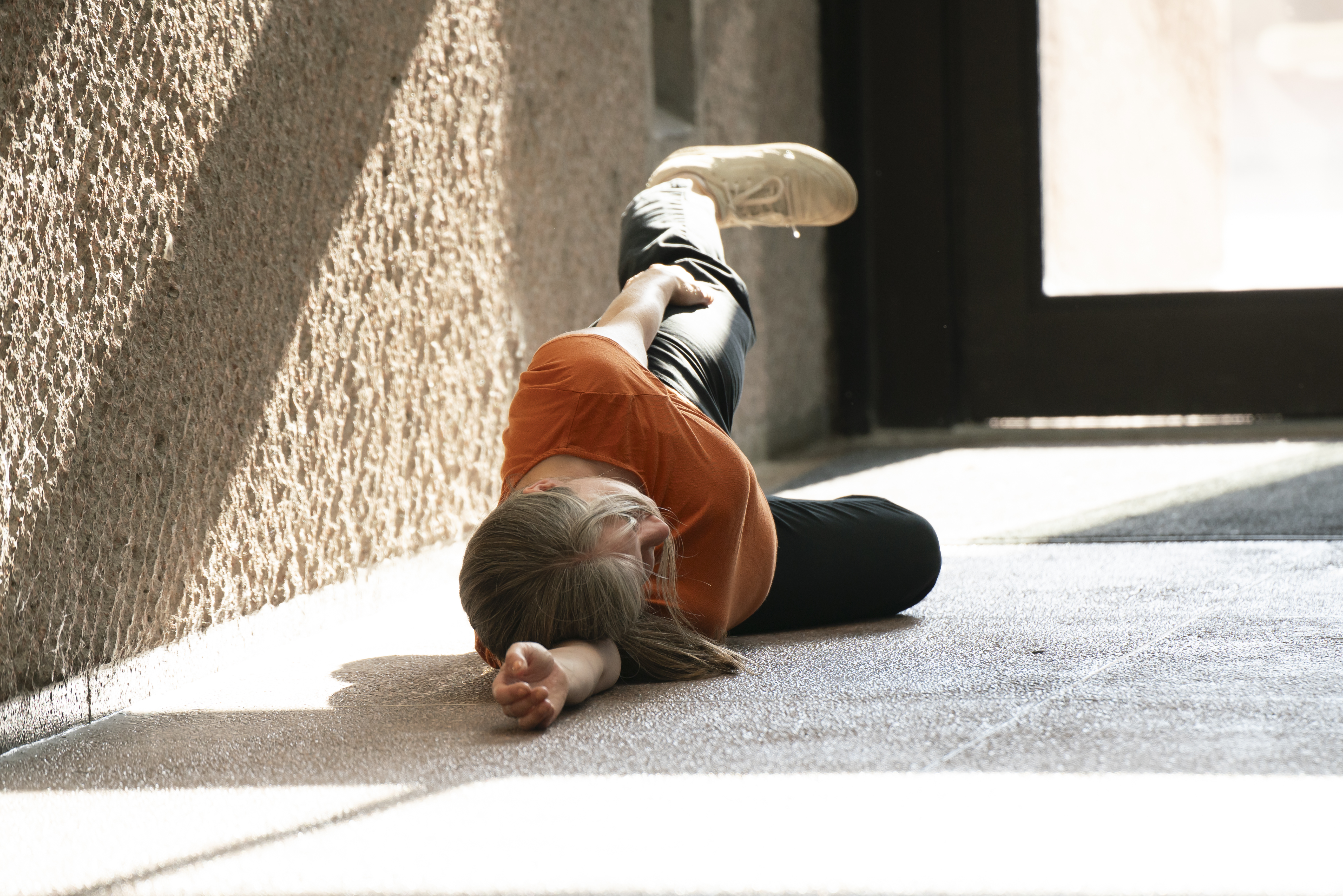


Events-As-Artworks
morning
(~9:21 am)
Recorded in Onoñda’gegá‘ nigaweño’deñ‘ (Onondaga Language) by Chief Spencer Ohsgoñ:da’ Lyons, this recording repeated in the museum's plaza every 59 minutes from sunrise to sunset using a lunar hour cycle (a reference to the Haudenosaunee lunar calendar).
Ganonhanyonh (Words that Come Before All Else) — the Haudenosaunee Thanksgiving Address
Recorded in Onoñda’gegá‘ nigaweño’deñ‘ (Onondaga Language) by Chief Spencer Ohsgoñ:da’ Lyons, this recording repeated in the museum's plaza every 59 minutes from sunrise to sunset using a lunar hour cycle (a reference to the Haudenosaunee lunar calendar).
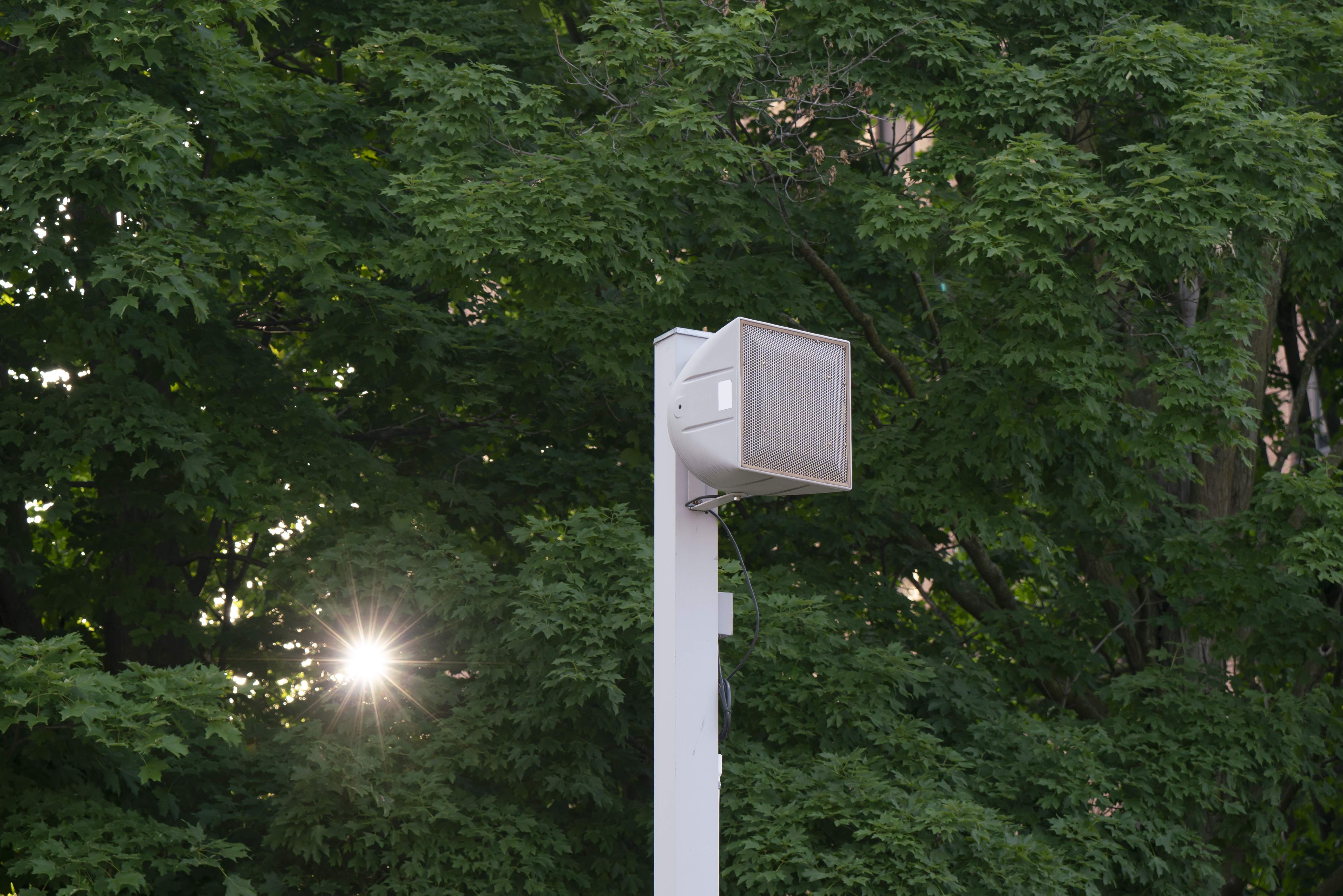
midmorning
(~10 am)
Haudenosaunee Timekeeping: Pasts, Presents
and Futures
This intimate workshop was offered for high school students and led by Brennen Ferguson, sitting Chief for the Tuscarora nation and Haudenosaunee Knowledge Keeper.
Haudenosaunee Timekeeping: Pasts, Presents
and Futures
This intimate workshop was offered for high school students and led by Brennen Ferguson, sitting Chief for the Tuscarora nation and Haudenosaunee Knowledge Keeper.
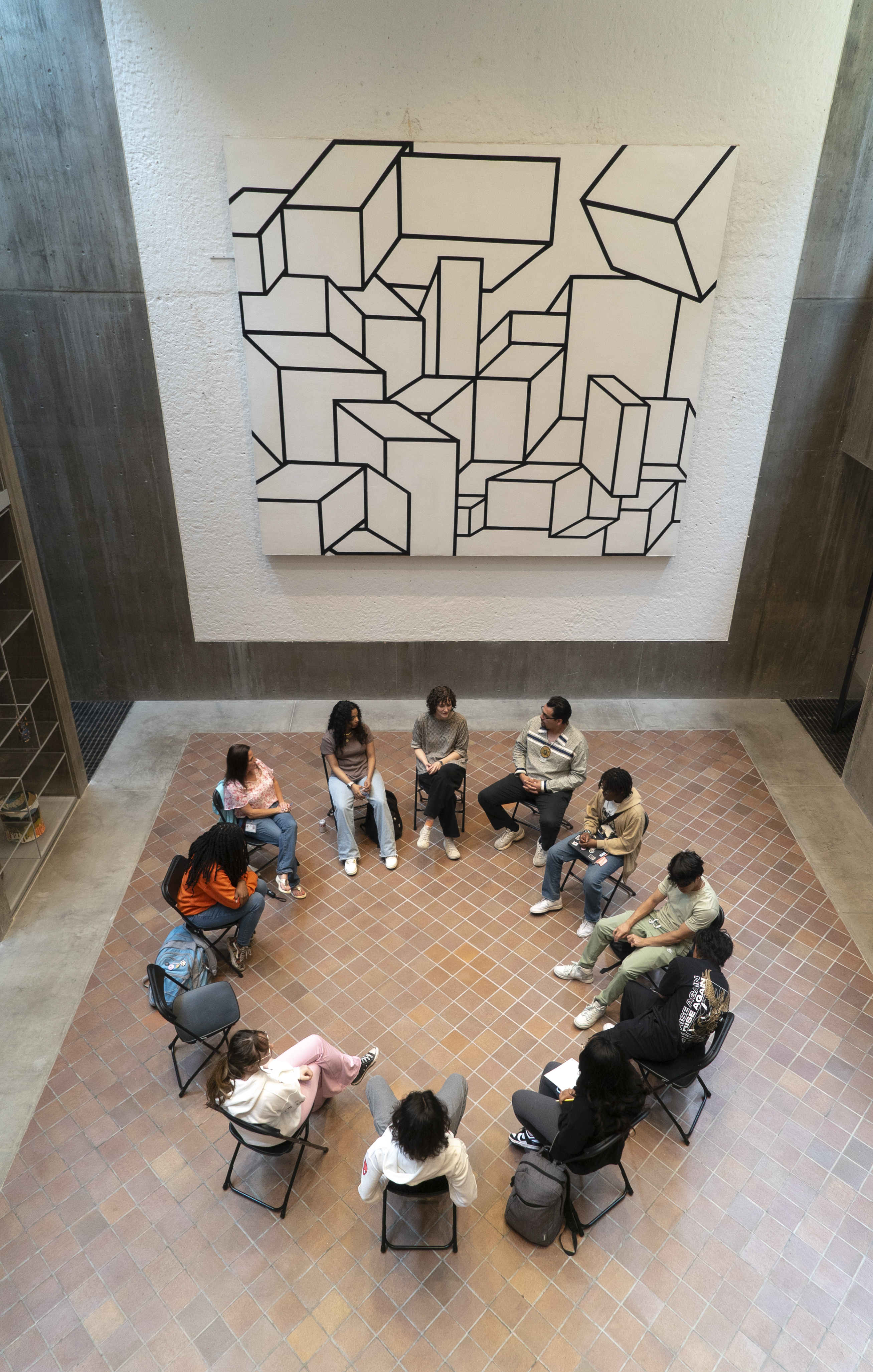

museum
hours (~11 am
- 8 pm)
Ask AL
Al Tallman has been a guard at the Everson Museum since April 24, 1994. Al is a living archive. Throughout the day, museum visitors were encouraged to find Al somewhere in the museum and ask him to tell a story about the museum from any year between 1994 and 2024.
Ask AL
Al Tallman has been a guard at the Everson Museum since April 24, 1994. Al is a living archive. Throughout the day, museum visitors were encouraged to find Al somewhere in the museum and ask him to tell a story about the museum from any year between 1994 and 2024.
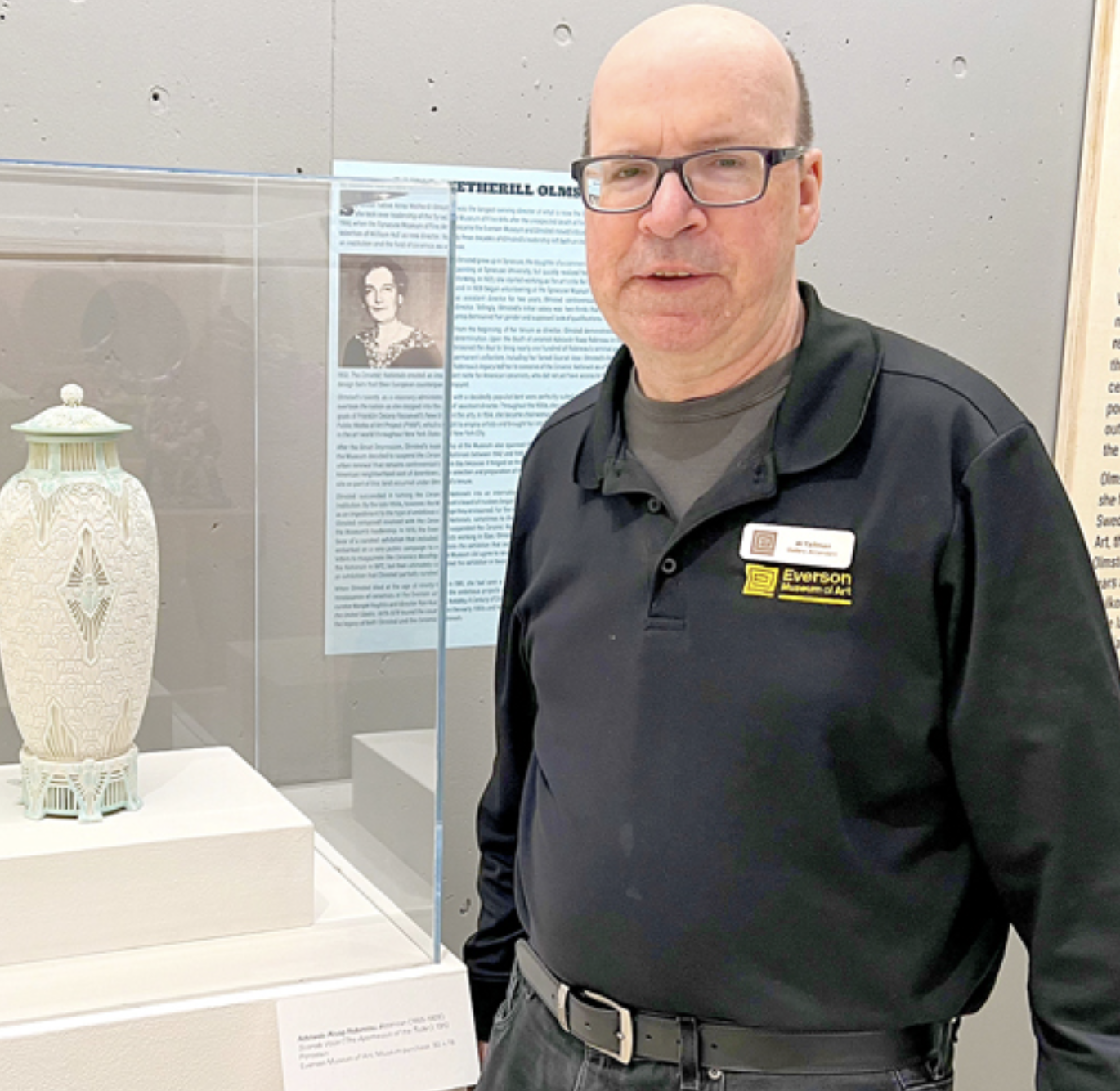
just before when the sun is highest in the sky (~12 - 1:30 pm)
The Rotating Clock: A Participatory, Time-Based Lunch-as-Artwork
This free lunch-as-artwork, oriented in the shape of a clock, featured a public conversation with 11 community leaders and one open seat for community input. Participants discussed the question, “What is Time Without A Clock?” Chef Lavina Fusco of Syracuse's PhokOttaHere + The Kitchen Literacy Project served Pho on handmade ceramic dishes from the Everson Museum’s Rosenfield collection.
The Rotating Clock: A Participatory, Time-Based Lunch-as-Artwork
This free lunch-as-artwork, oriented in the shape of a clock, featured a public conversation with 11 community leaders and one open seat for community input. Participants discussed the question, “What is Time Without A Clock?” Chef Lavina Fusco of Syracuse's PhokOttaHere + The Kitchen Literacy Project served Pho on handmade ceramic dishes from the Everson Museum’s Rosenfield collection.
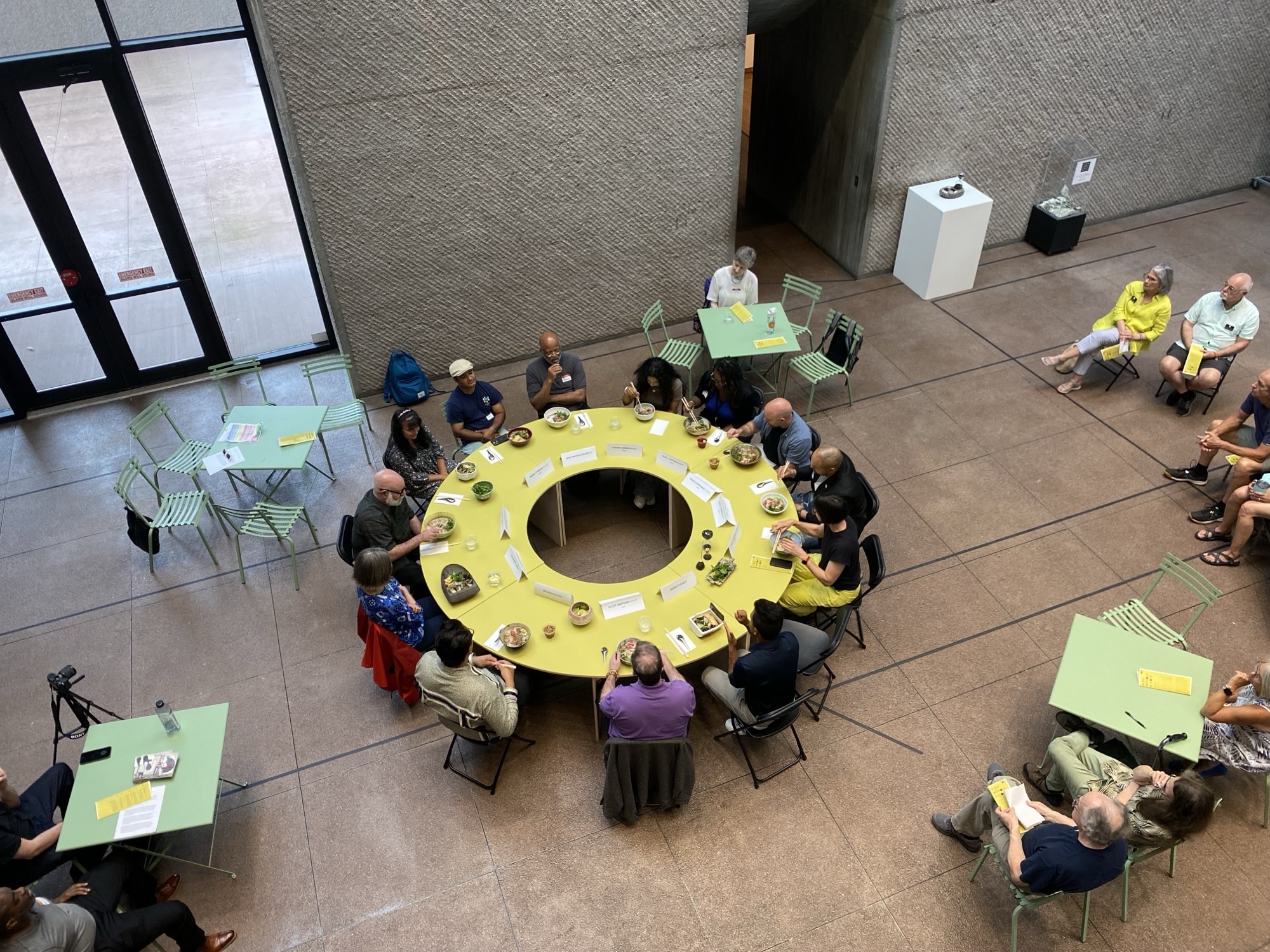
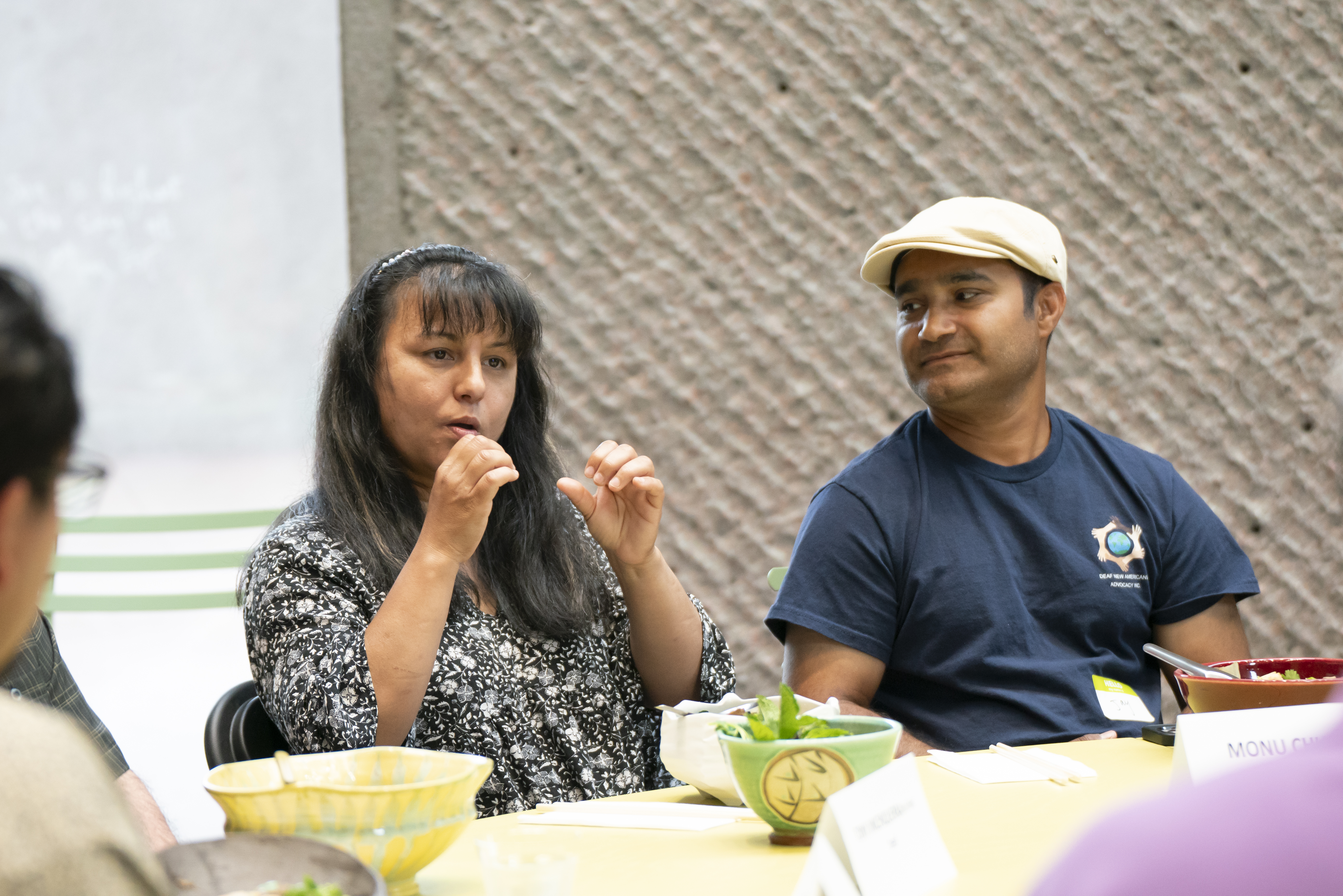

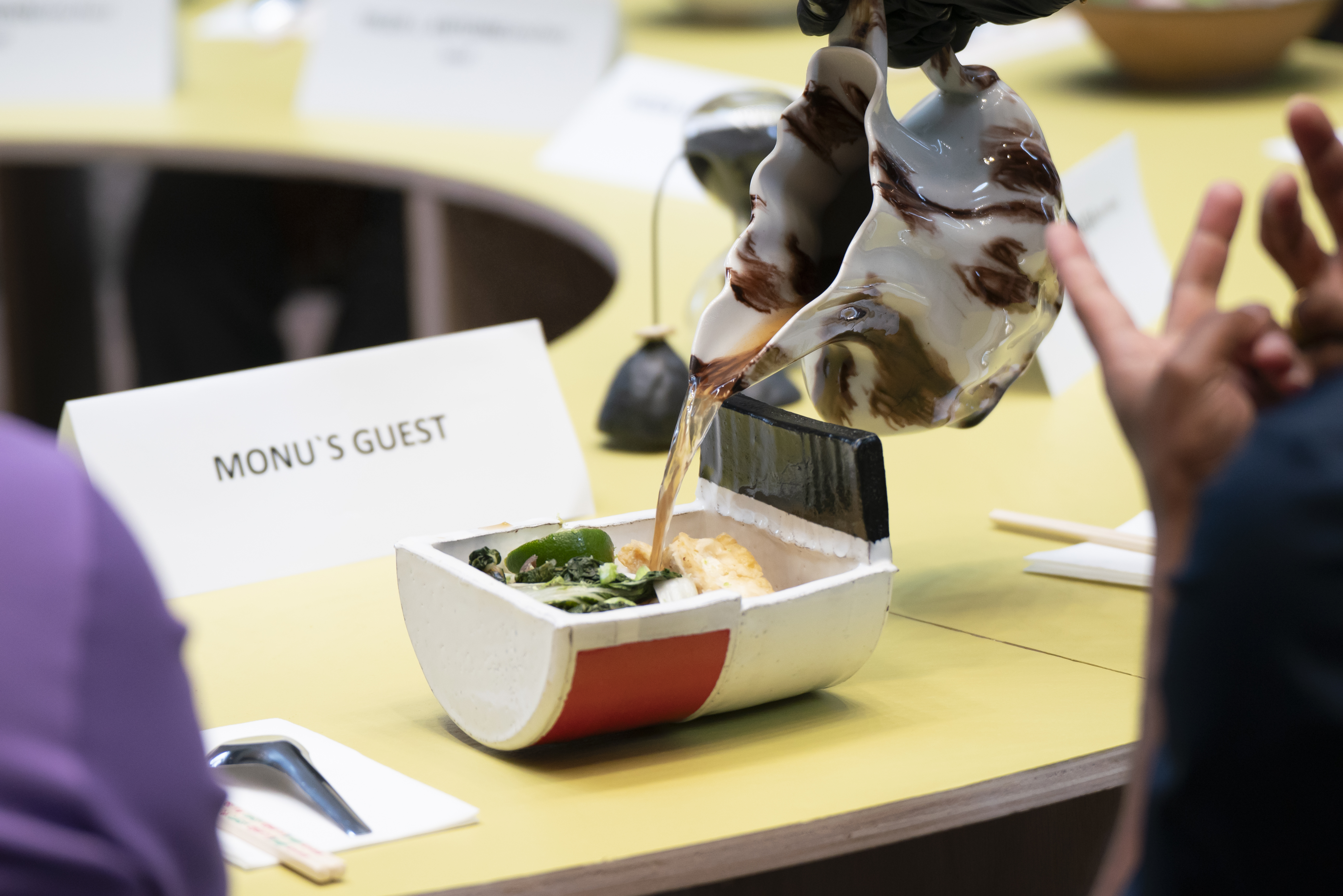
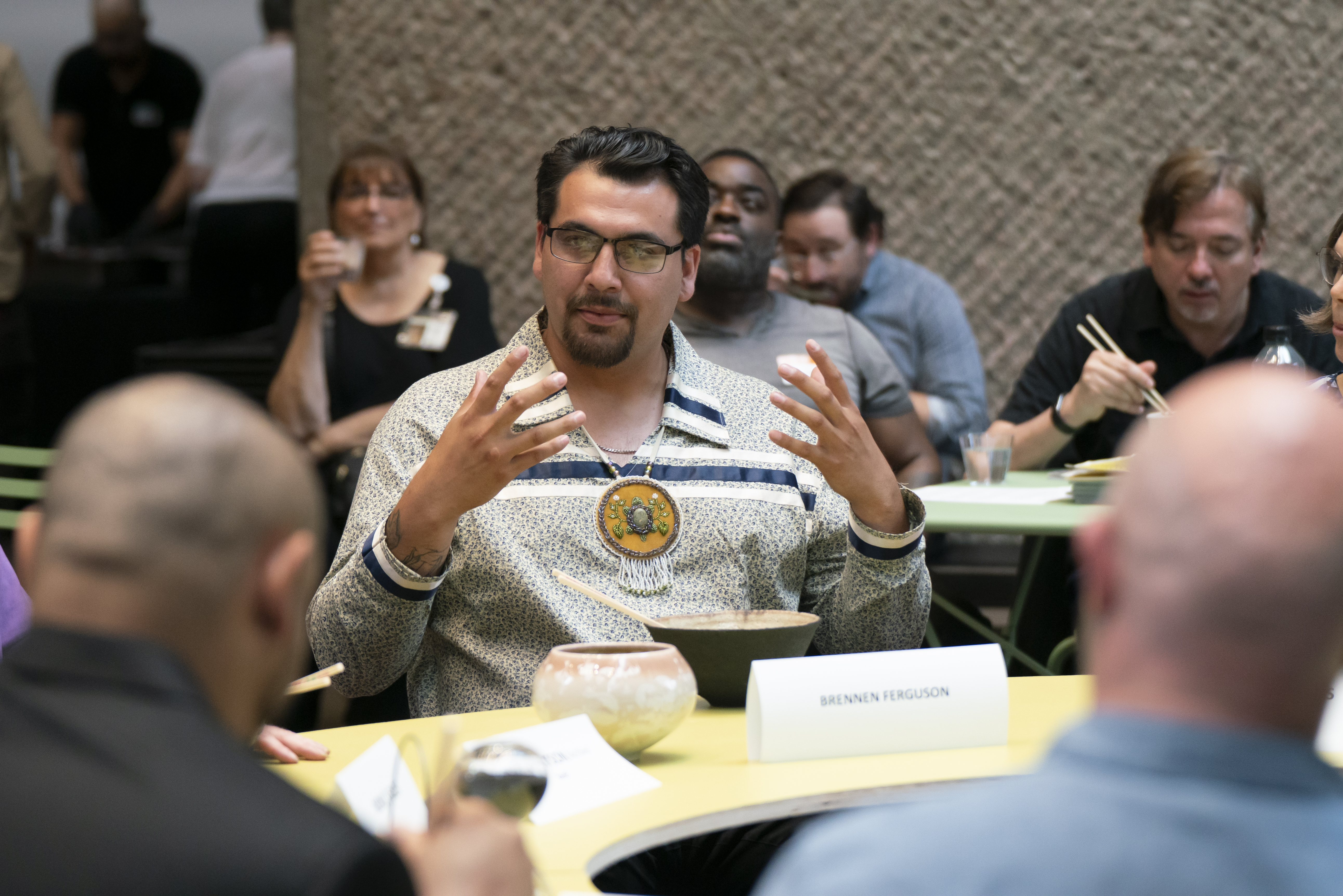
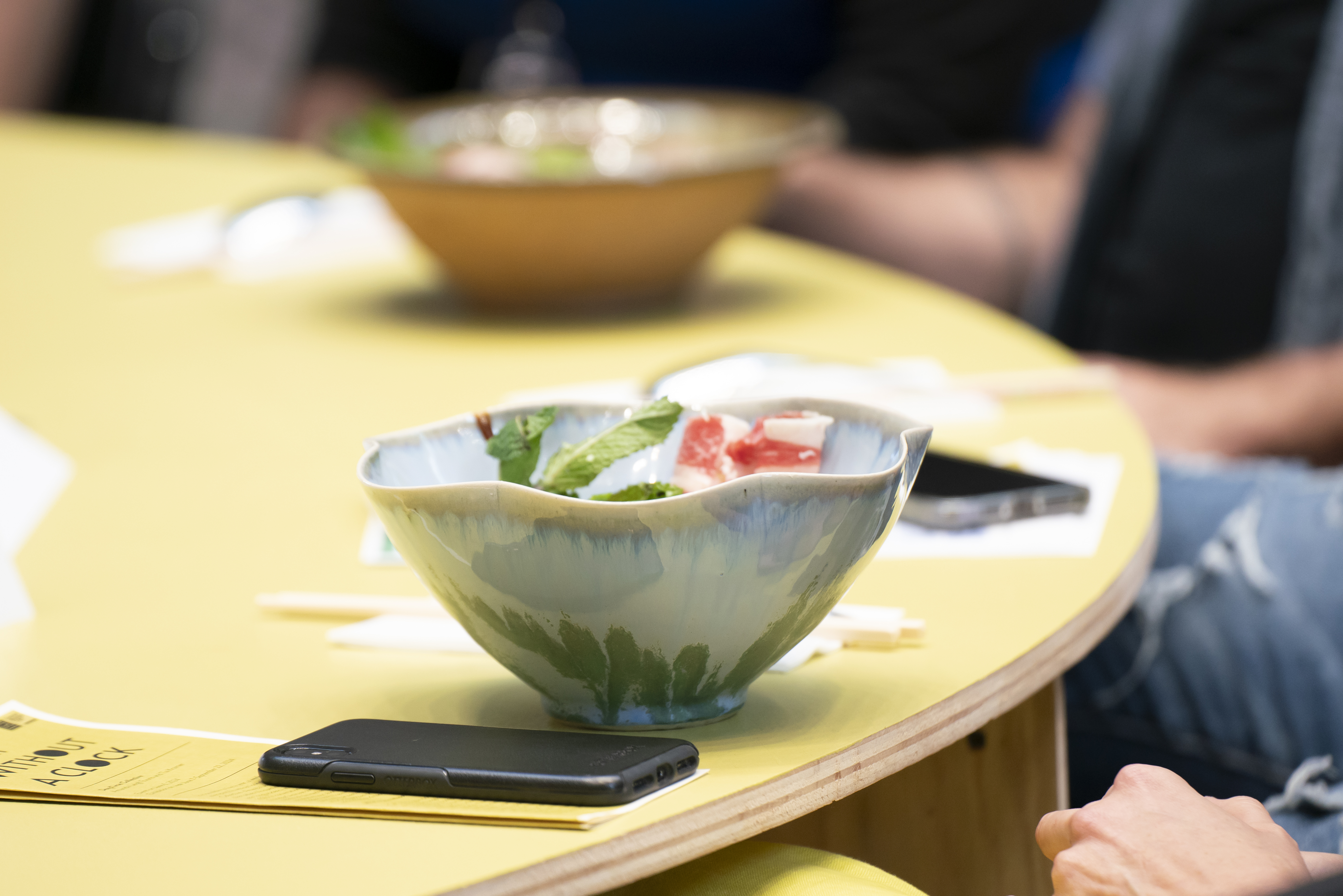
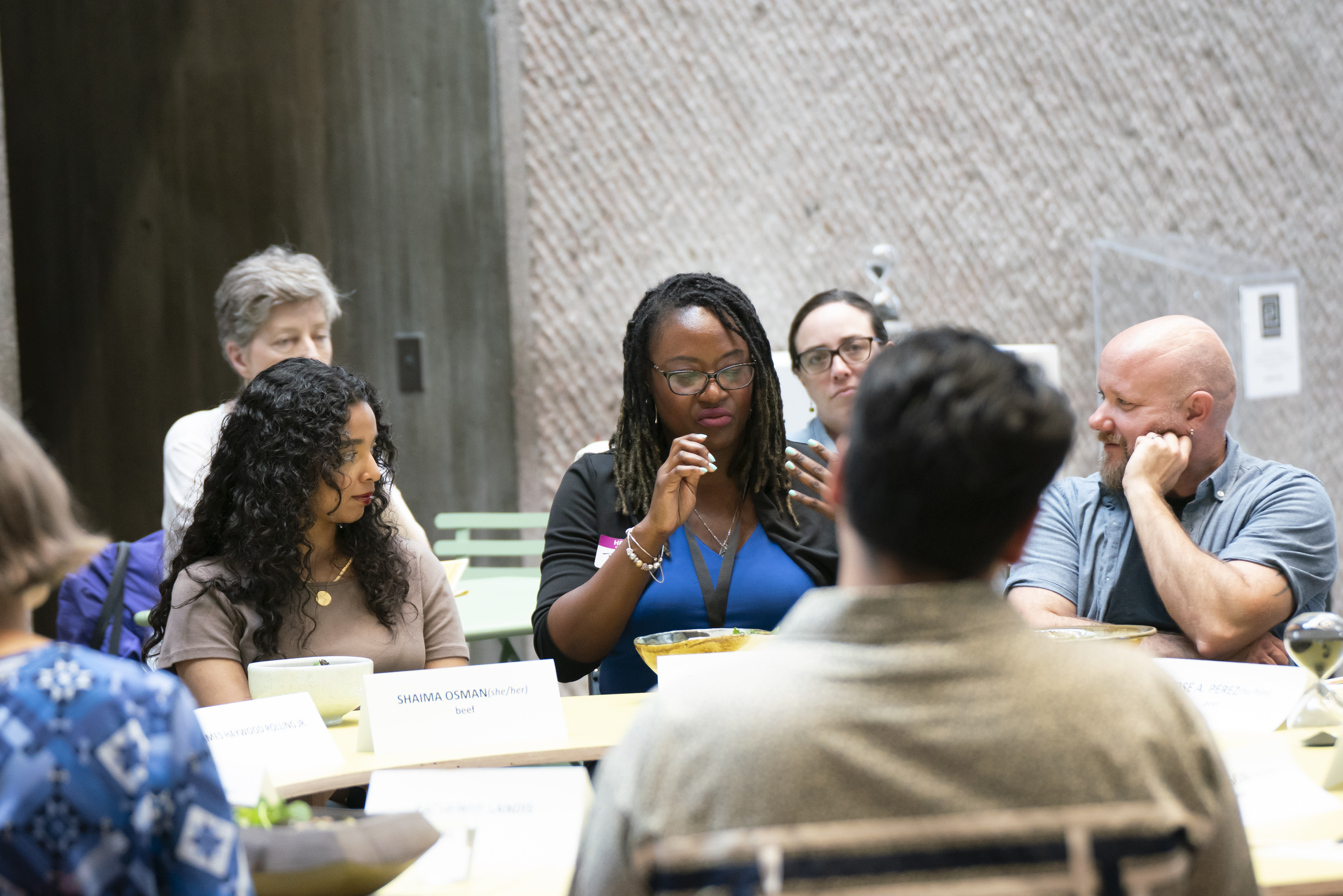
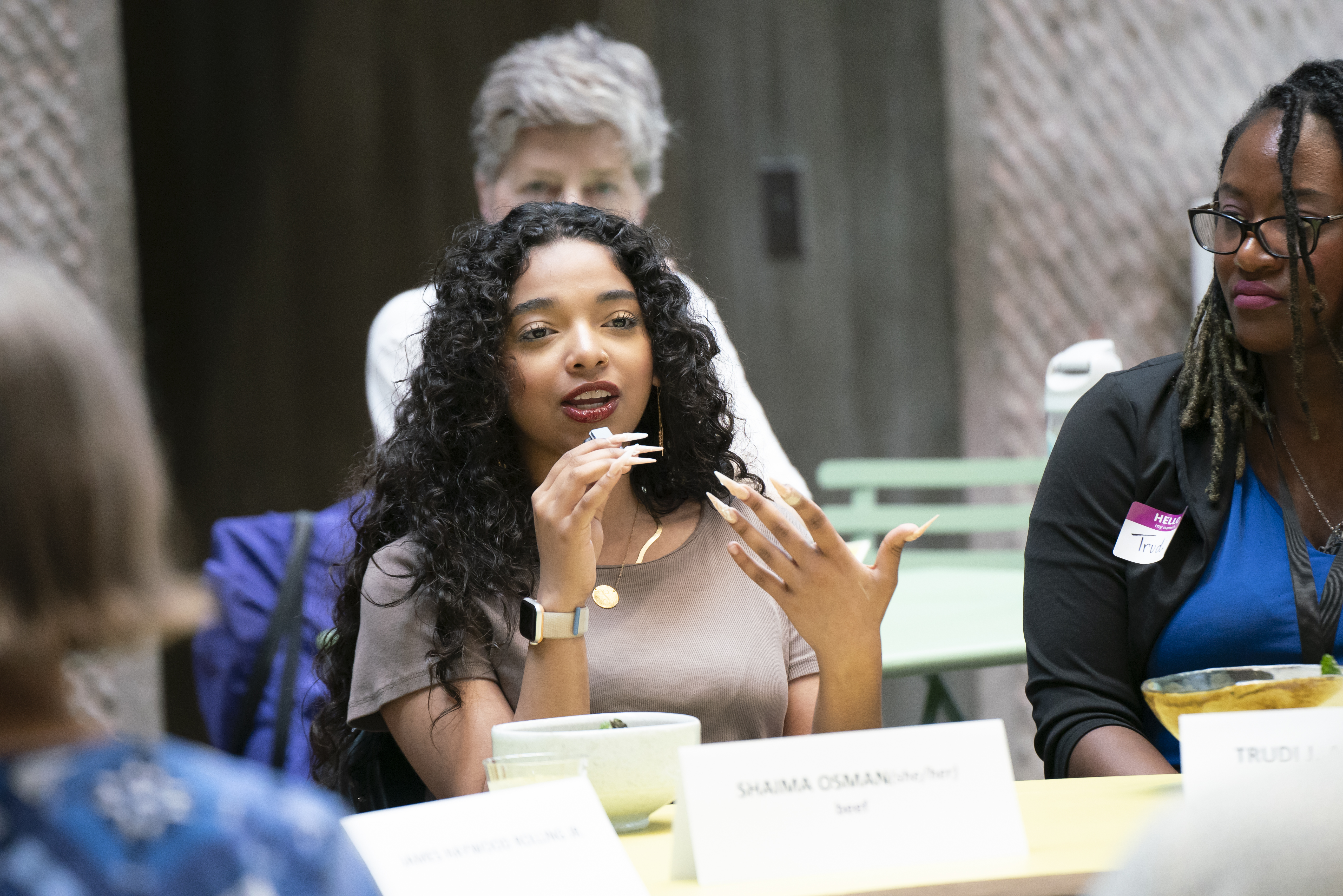
mid afternoon
(~2:30 - 3:30 pm)
Time While Doing Time: Readings by Formerly
Incarcerated Authors
José A. Pérez, Marvin Wade, and editors from Project Mend read original essays by formerly incarcerated writers. This event wasco-produced and facilitated by Project Mend.
Time While Doing Time: Readings by Formerly
Incarcerated Authors
José A. Pérez, Marvin Wade, and editors from Project Mend read original essays by formerly incarcerated writers. This event wasco-produced and facilitated by Project Mend.
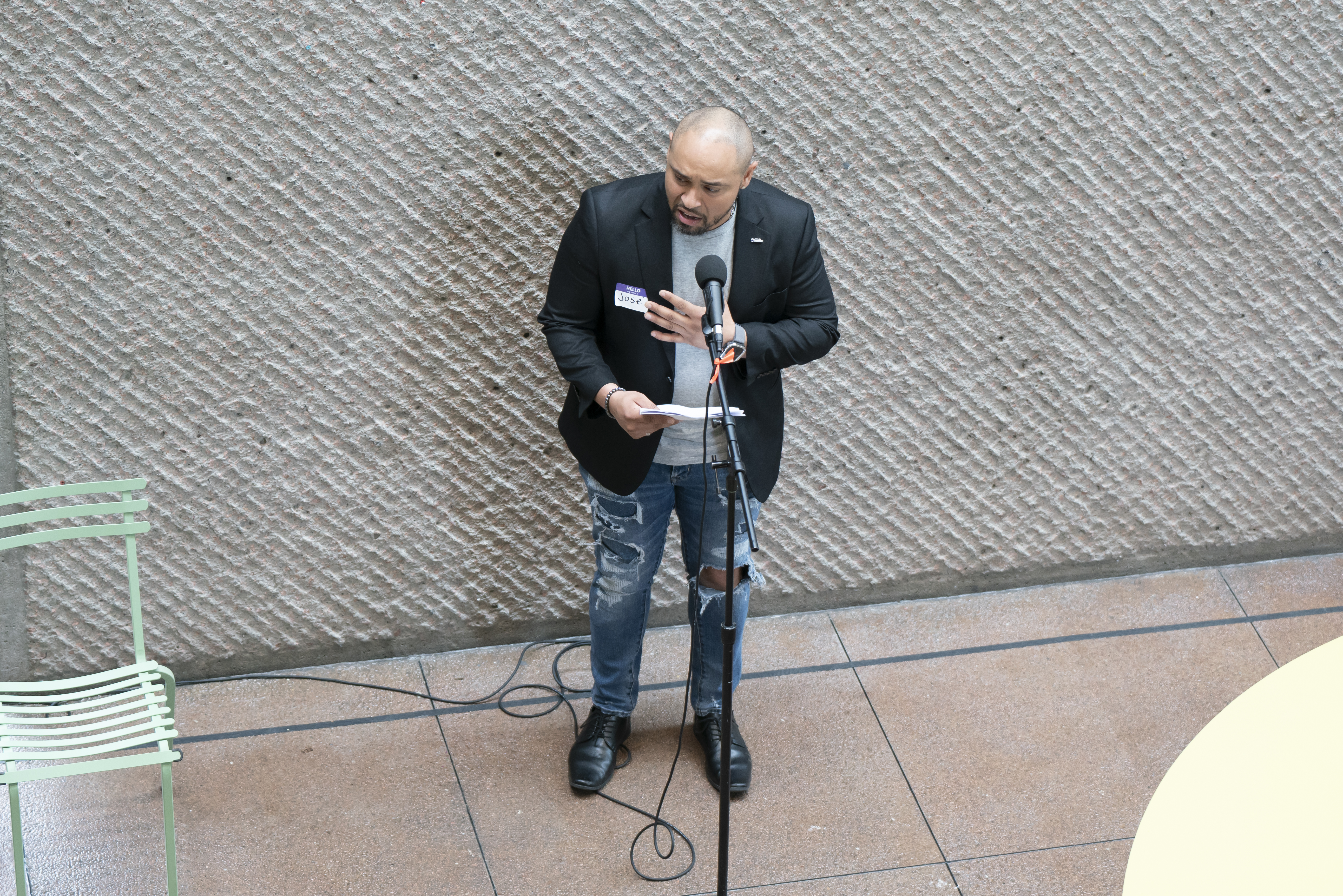

late afternoon (~4 - 5 pm)
Queering Time
This intimate workshop began with a study of Félix González-Torres’ conceptual artwork, "Untitled" (Perfect Lovers), 1991, and concluded with making our own made our own timekeeping devices that queer our sense of time and clocks
Queering Time
This intimate workshop began with a study of Félix González-Torres’ conceptual artwork, "Untitled" (Perfect Lovers), 1991, and concluded with making our own made our own timekeeping devices that queer our sense of time and clocks
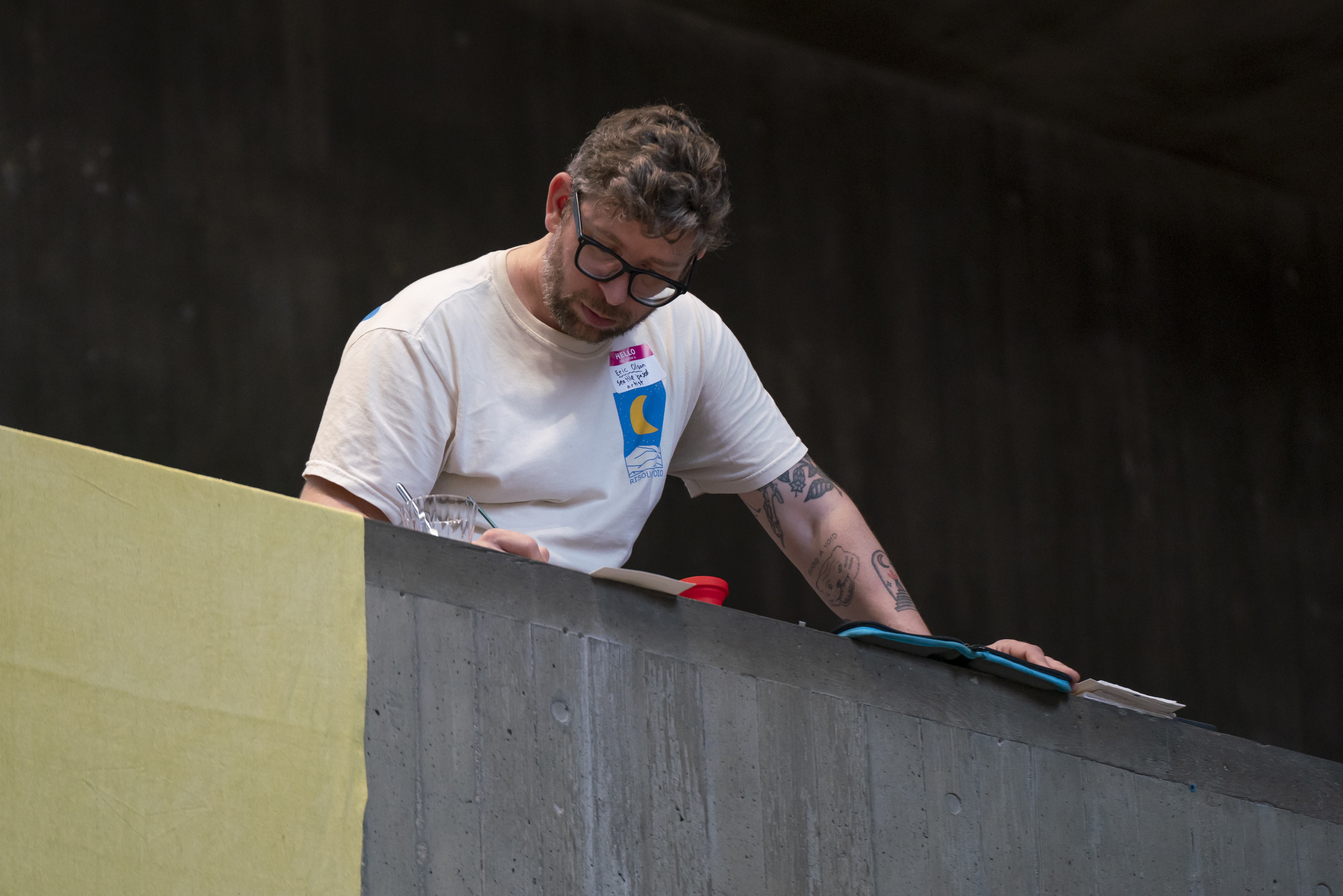
early evening (~6 - 7 pm)
Songs for Keeping Time
This participatory event was collaboratively led with the Syracuse Community Choir. Together we sang historic labor and other timekeeping songs and learned about how people have used song to keep time throughout history. No singing experience was necessary.
Songs for Keeping Time
This participatory event was collaboratively led with the Syracuse Community Choir. Together we sang historic labor and other timekeeping songs and learned about how people have used song to keep time throughout history. No singing experience was necessary.
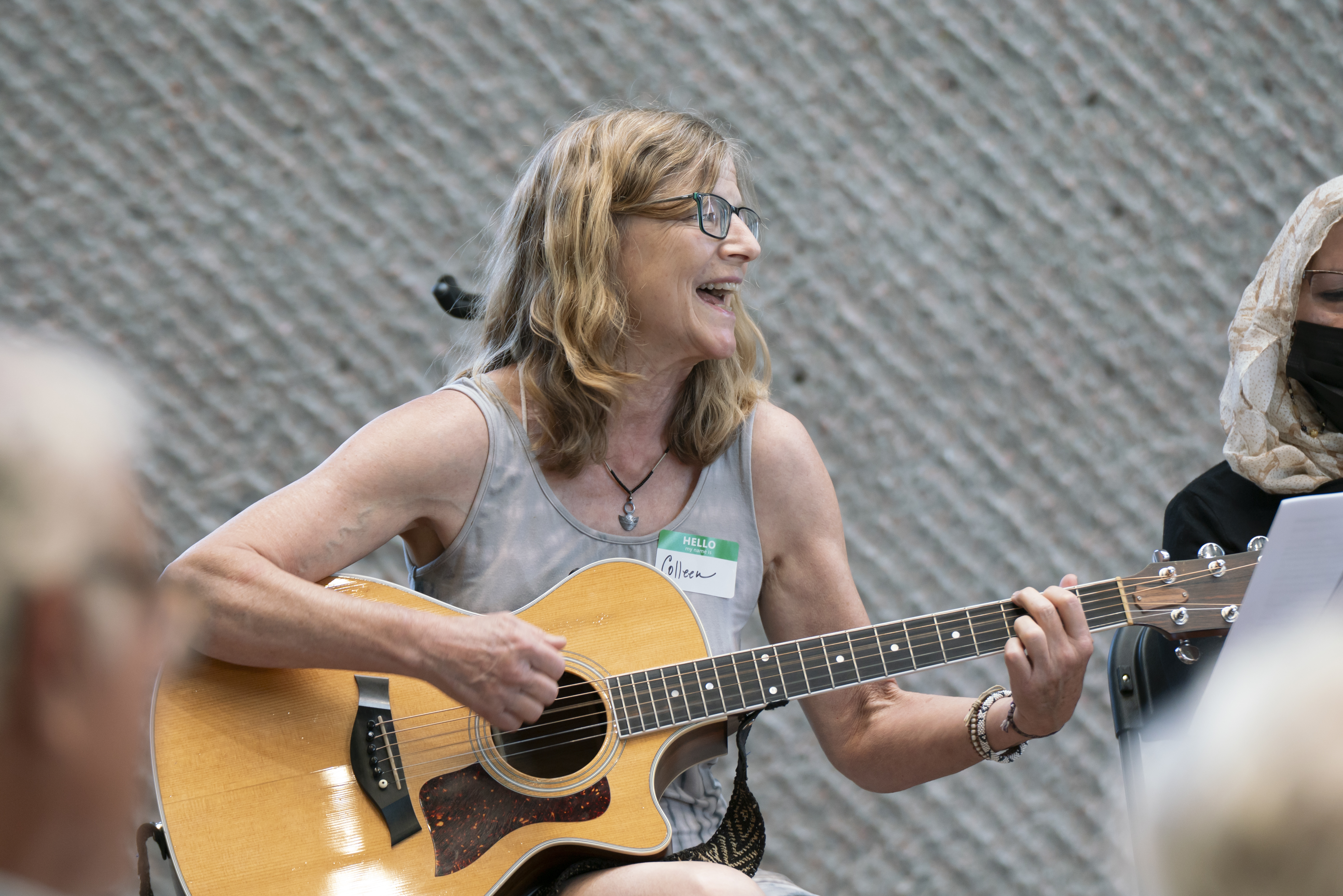
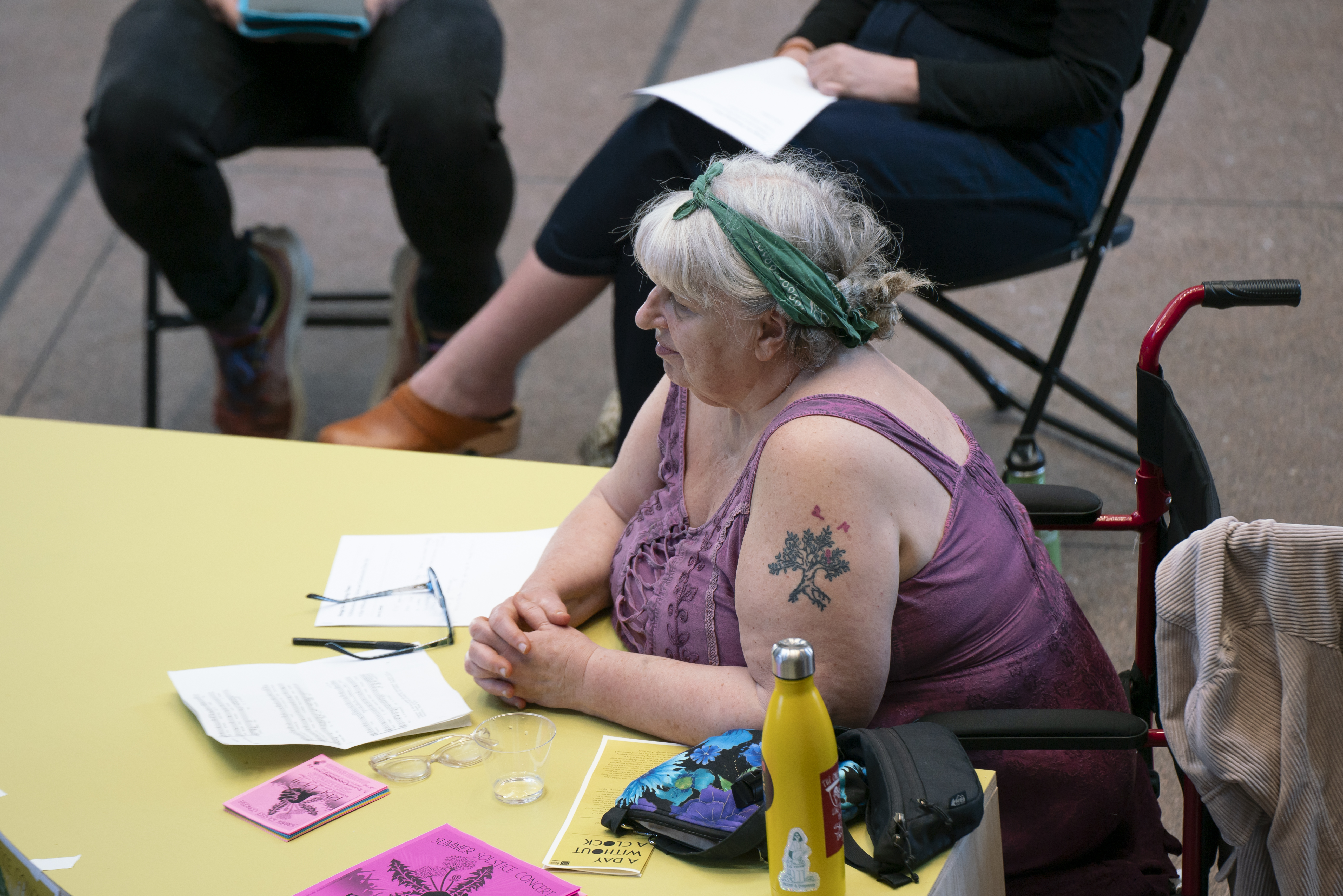
dusk (~7:30 -
8:30 pm)
The Universe is a Clock
Is the universe the biggest clock of all? The day condluded with a sunset conversation about cosmological time with physicist Scott Watson. Before and after the talk on cosmology, The Music for People Collective (Karl Sperber on guitar, Jessica Wooldridge King on bassoon, and Alina Plourde on oboe) played improvised, minimalist music scores relating to time.
The Universe is a Clock
Is the universe the biggest clock of all? The day condluded with a sunset conversation about cosmological time with physicist Scott Watson. Before and after the talk on cosmology, The Music for People Collective (Karl Sperber on guitar, Jessica Wooldridge King on bassoon, and Alina Plourde on oboe) played improvised, minimalist music scores relating to time.
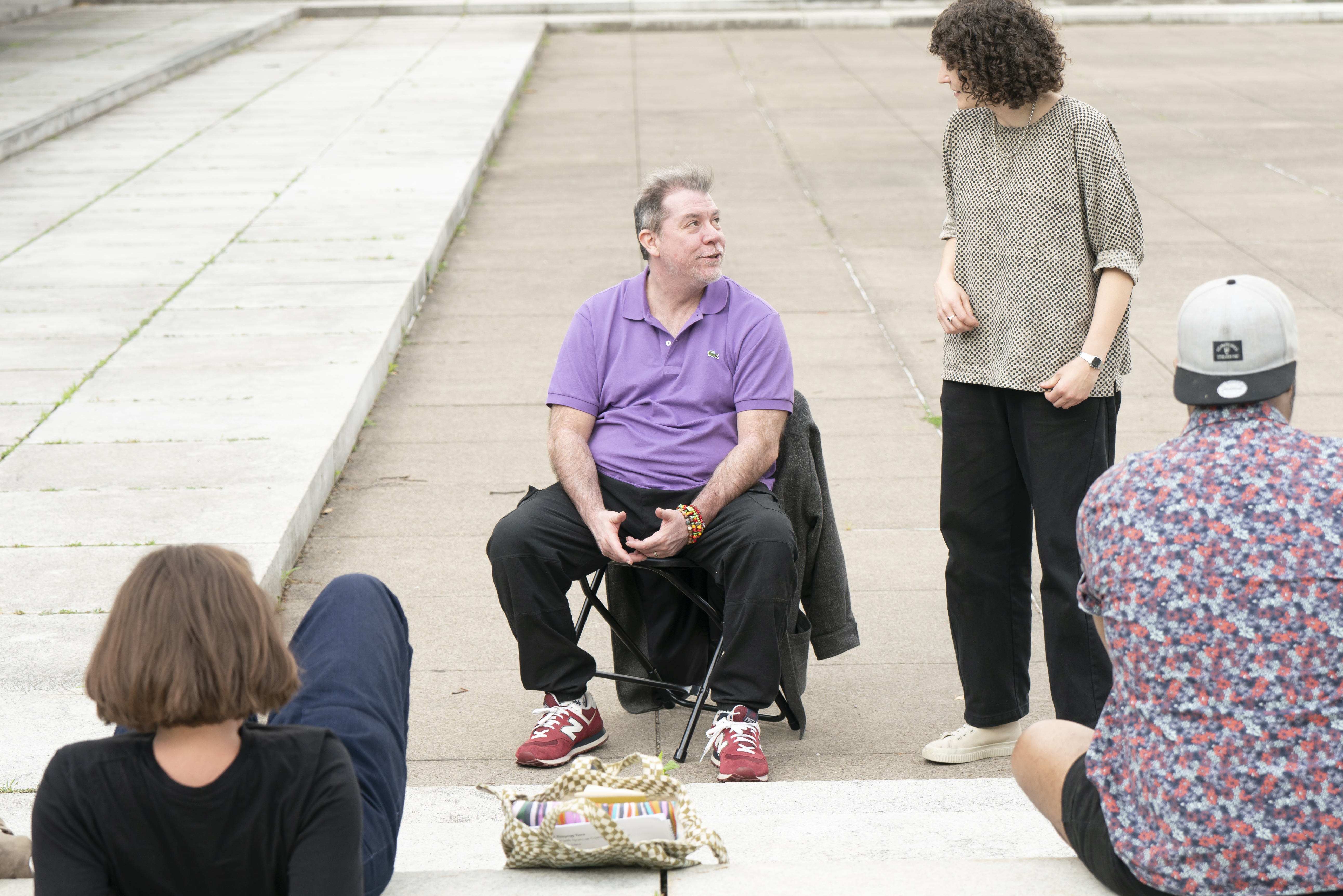
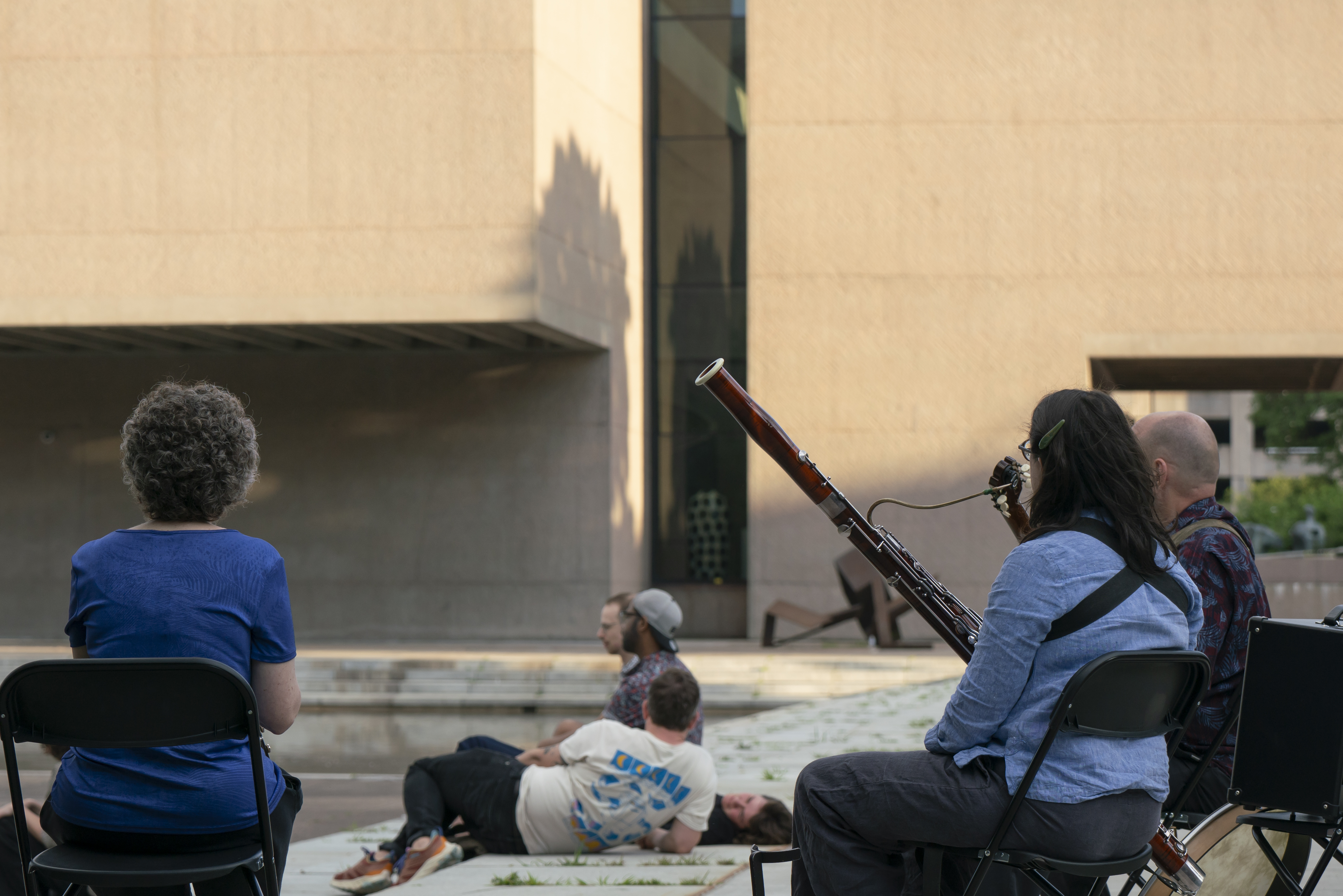
civil twilight (~8:40 pm)
Everson in 177 Years
The city of Syracuse was incorporated in 1847 (177 years ago). Landscape Architect Aiden Ackerman was commissioned by DeepTime Collective to create a video simulation of what the Everson Museum plaza might look like 177 years in the future. This simulation was projected on the side of the museum at twilight, creating a symmetry between the city's past and the city's future.
Everson in 177 Years
The city of Syracuse was incorporated in 1847 (177 years ago). Landscape Architect Aiden Ackerman was commissioned by DeepTime Collective to create a video simulation of what the Everson Museum plaza might look like 177 years in the future. This simulation was projected on the side of the museum at twilight, creating a symmetry between the city's past and the city's future.
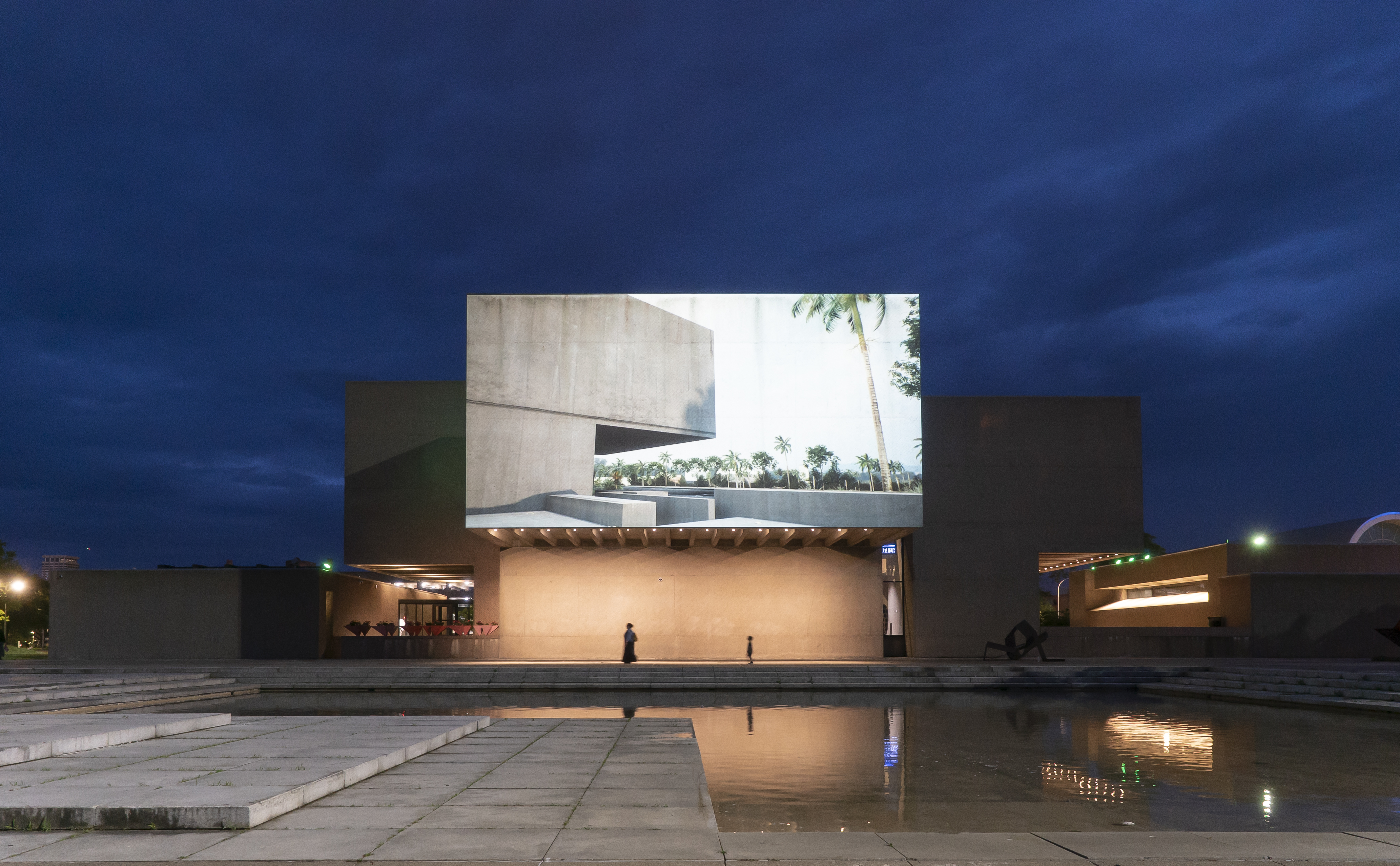
All images courtesy Daylight Blue Media / Mike Barletta, Roz Crews, and Aidan Ackerman
This project was supported in part by the National Endowment for the Arts. The Everson is supported by the Dorothy and Marshall M. Reisman Foundation; the General Operating Support program, a regrant program of the County of Onondaga with the support of County Executive, J. Ryan McMahon II, and the Onondaga County Legislature, administered by CNY Arts; and the New York State Council on the Arts with the support of the Office of the Governor and the New York State Legislature.





